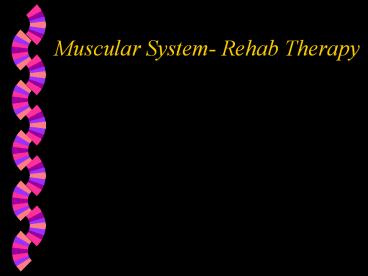Muscular System- Rehab Therapy - PowerPoint PPT Presentation
Title:
Muscular System- Rehab Therapy
Description:
Title: MUSCULAR SYSTEM Author: Ginger A. McPherson Last modified by: CA18006 Created Date: 6/7/2001 12:14:23 AM Document presentation format: On-screen Show – PowerPoint PPT presentation
Number of Views:114
Avg rating:3.0/5.0
Title: Muscular System- Rehab Therapy
1
Muscular System- Rehab Therapy
2
MUSCULAR SYSTEM
- If you weigh 120 pounds, how much of the weight
is muscle?
3
Approximately 50 pounds
4
MUSCLE TISSUE- 3 Types
- SKELETAL- attached to bone, voluntary, straited
(because of stripes straie) - CARDIAC- heart muscle
- SMOOTH- nonstraited, involuntary, found in
visceral(organs) and blood vessel walls
5
FUNCTION OF MUSCLES- to contract and lengthen
- SKELETAL MUSCLE FUNCTION 1)
MOVEMENT 2) POSTURE- MUSCLE TONE 3) HEAT
PRODUCTION
6
MOVEMENT
- Muscles move bones by pulling on them, shortening
and contracting. - The muscle that is the main one responsible for
movement is called the PRIME MOVER. The other
muscles that help are called SYNERGISTS.
7
When prime movers synergists contract, other
muscles called ANTAGONISTS relax. When
antagonists contract they produce movement
opposite to prime movers synergists.
8
POSTURE
- Tonic Contractions- does not move any body part,
holds them in position. This is known as posture. - Isometric Contractions- muscle does not shorten
no movement occurs. Ex.- pushing against a wall
9
- Isotonic contraction- produces movement at a
joint such as walking, running or breathing - Twitch contraction- quick jerky contraction
10
- Tetanic contraction- more sustained contraction
than a twitch. This is where the name tetanus
comes from because of the severe cramping also
known as lock-jaw.
11
TENDONS
- Dense fibrous connective tissue that acts as
cords, connects muscle to bone
12
BURSAE
- Small fluids filled sacs that lie between some
tendons bones - Bursitis- inflammation of the bursae
13
Bursae
- lined with synovial membrane which secretes a
fluid (synovial) that fills the bursae - This fluid acts as a cushion
14
MOVEMENTS
- Flexion- movement that makes a joint angle
smaller - Extension- movement that makes joint angle larger
15
- Abduction- moving body part away from the
midline abduct - Adduction- moving body part toward the midline
add
16
ROTATION
- Moving around longitudinal axis example shaking
your head no
17
- Supination- turn palm of hand anterior or up as
with the anatomical position - Pronation- turn the palm to posterior position or
down
18
- Dorsiflexion- elevate top of foot toward knee
- Plantarflexion- point foot downward as if you are
standing on toes
19
LIGAMENTS
- Strong fibrous connective tissue that grows out
of the periosteum connects two bones together.
20
MUSCULAR DISORDERS
- Muscular dystrophy- progressive wasting away of
muscles - Muscular atrophy- muscle shrinkage. Why would
this occur?
21
- Muscular hypertrophy- increase in muscle size
22
Paralysis
- Injury to brain or spinal cord in which muscles
cannot contract - Hemiplegia- paralysis on side
- Paraplegia- paralysis waist down
- Quadraplegia- paralysis from neck down
23
Three parts of a muscle
- Body- main part of the muscle
- origin
- insertion
24
ORIGIN
- Muscle Attaches to relatively stationary bone
25
INSERTION
- Muscle attaches to part of bone that moves
26
- REFER TO HANDOUT ON INDIVIDUAL MUSCLES- DISCUSS

